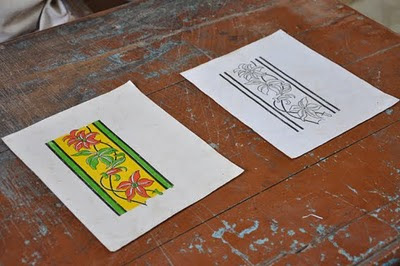Making Space:Sensing Place
In October 2009, along with artist Thurle Wright, I was awarded a Making Space:Sensing Place Fellowship; part of the HAT: Here and There International Exchange Programme, managed by A Fine Line:Cultural Practice. The Fellowship includes residencies with Britto Arts in Dhaka, Bangladesh, with Arts Reverie in Ahmedabad, Gujarat, with The V&A Museum of Childhood, Bethnal Green, London and with The Harley Gallery, Nottinghamshire. Working and collaborating with artists and craftspeople from the UK, Bangladesh and India, responding to the collections and spaces we encounter and sharing these experiences through a touring exhibition and educational workshops.
This blog, which is still developing and being added to, is a record of my experiences during the MS:SP Fellowship. Steven Follen.
www.stevenfollen.com





 Blind now in one eye, loosing the sight in his other, due to ageand cataracts we spent the afternoon in what was once his workshop listening to his story.
Blind now in one eye, loosing the sight in his other, due to ageand cataracts we spent the afternoon in what was once his workshop listening to his story. LOkesh had taken us there, he knew the man and had visited many times before. With his ailing eyes and health there was a concern among his friends that what remained of this master craftsmans work and the history held in the generations of sample books and blocks he had around him might be lost if it was not recorded. The old man wanted the collection of his lifes work to be held together, placed in a museum for all to see and learn from, that the tradition of which he was a part would continue in some way. He hoped that the remains of his craft might provide the funds for the operation to prolong his eyesight and sustain him in his remaining years.
LOkesh had taken us there, he knew the man and had visited many times before. With his ailing eyes and health there was a concern among his friends that what remained of this master craftsmans work and the history held in the generations of sample books and blocks he had around him might be lost if it was not recorded. The old man wanted the collection of his lifes work to be held together, placed in a museum for all to see and learn from, that the tradition of which he was a part would continue in some way. He hoped that the remains of his craft might provide the funds for the operation to prolong his eyesight and sustain him in his remaining years. All around the workshop were examples of his work, books and cuttings from articles
All around the workshop were examples of his work, books and cuttings from articles

 He explained the process of preparing the blocks from teak wood smoothing the surface, transfering the design, drilling the holes which would then be chiseled out. making multiple colour blocks from the first impressions
He explained the process of preparing the blocks from teak wood smoothing the surface, transfering the design, drilling the holes which would then be chiseled out. making multiple colour blocks from the first impressions





 Different colour combinations.
Different colour combinations.













 Prints to mimic the Double Ikat weaving (Patola) produced in nearby Patan.
Prints to mimic the Double Ikat weaving (Patola) produced in nearby Patan.


 Blocks produced by hammering folded and formed, flattened metal wire 'edge-on' into the blocks.
Blocks produced by hammering folded and formed, flattened metal wire 'edge-on' into the blocks.







